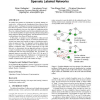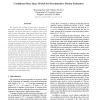357 search results - page 53 / 72 » The Use of Classifiers in Sequential Inference |
KDD
2008
ACM
14 years 9 months ago
2008
ACM
We address the problem of classification in partially labeled networks (a.k.a. within-network classification) where observed class labels are sparse. Techniques for statistical re...
CVPR
2009
IEEE
15 years 3 months ago
2009
IEEE
Many problems in computer vision can be modeled using
conditional Markov random fields (CRF). Since finding
the maximum a posteriori (MAP) solution in such models
is NP-hard, mu...
ICCV
2007
IEEE
14 years 10 months ago
2007
IEEE
We consider the problem of predicting a sequence of real-valued multivariate states from a given measurement sequence. Its typical application in computer vision is the task of mo...
ICML
2004
IEEE
14 years 9 months ago
2004
IEEE
Markov networks are extensively used to model complex sequential, spatial, and relational interactions in fields as diverse as image processing, natural language analysis, and bio...
VMCAI
2009
Springer
14 years 3 months ago
2009
Springer
We present the first shape analysis for multithreaded programs that avoids the explicit enumeration of execution-interleavings. Our approach is to automatically infer a resource ...


